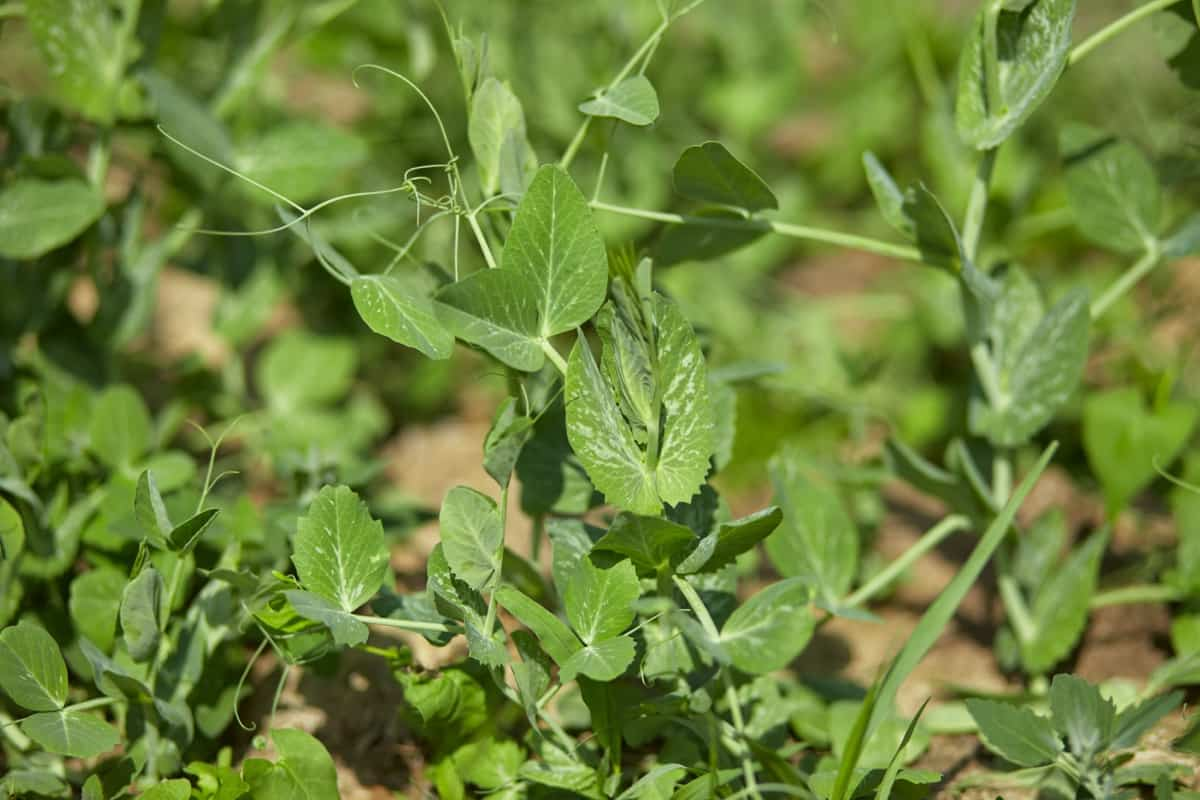Raised beds benefit greatly from cover crops. Over time, raised beds can lose their soil structure, becoming compacted. Additionally, they can lose nutrients over time without supplements like organic matter like compost or fertilizers. The best option is green manure, otherwise known as cover crops. In your home vegetable garden, there are several options for cover crops, from leguminous crops that fix nitrogen to flowering crops like alfalfa that are beneficial to pollinators and other insects. Below are some examples of growing as cover crops on raised beds.
10 Cover Crops for Raised Beds
Alfalfa
Alfalfa is one of the perennial cover crops in the pea family that fixes nitrogen in the soil. Following crops that deplete the soil of nitrogen, such as corn, is the best time to plant it. Because of its high protein content, it is commonly used as forage for farm animals. Cover crops like this can be chopped, dropped like straw mulch, and utilized similarly. The foliage should be cut back to the soil level, and then the greens should be placed on it. Over the winter, allow them to dry out and break down. You can then plant your next crop as you normally would in the spring.
In case you missed it: How to Treat Your Crops from Fusarium Wilt?

Buckwheat
Buckwheat, as a cover crop for raised beds, is that it is a fast-growing plant. This means it can be sown between crop cycles to help improve soil quality and prevent erosion. Buckwheat grows rapidly and produces a lot of biomass, which helps to suppress weed growth and prevent soil compaction. Buckwheat has a deep root system, which helps to break up compacted soil.
As the roots of the buckwheat plant grow deeper into the soil, they help to aerate the soil and improve drainage. This allows air, water, and nutrients to reach other plants’ roots more easily, leading to healthier and more productive plants. Buckwheat is also a good choice for raised bed gardening because it is a nitrogen-fixing plant.
Clover
Clover is a great choice for cover crops in raised beds because it is a nitrogen fixer. This makes clover an excellent choice for cover crops, as it can help improve soil fertility and provide a nitrogen source for future crops. In addition to its nitrogen-fixing abilities, clover has a deep root system that can help improve soil structure and prevent erosion. The deep roots of clover can help to break up compacted soil, allowing air and water to penetrate more easily. This can help to improve overall soil health and reduce the risk of soil erosion.
Oats
Oats are another grass that can be grown over winter and into spring, like rye. Home gardeners who live in a temperate climate with a short growing season will enjoy this option. It is possible to sow oats in the fall and grow them over the winter or in the spring and grow them into the late summer. Cover crops such as oats suppress weeds very effectively, which is one of their benefits.
By covering the soil, oats prevent weed growth, reducing the need for manual weeding. This can save time and effort for gardeners, as well as reduce the need for herbicides. Additionally, oats are known for their ability to improve soil health. As they grow, they absorb nutrients from the soil, which they then release back into the soil when tilled under. This process improves soil fertility and helps to prevent soil erosion.
Millets
Growing and maintaining millets, a group of small-seeded grasses, is easy. As a result, they are ideal for use as cover crops due to their hardiness and ability to withstand harsh weather conditions. Millets are also fast-growing, which means they can quickly establish themselves in raised beds and start providing benefits to the soil.
In case you missed it: 1-Acre Project Report of Amaranth Millet/Grain Farming: Production Economics, Cultivation Cost and Profit

One of the primary benefits of using millets as a cover crop is their ability to help control soil erosion. The roots of millets are very dense and can help hold the soil in place, preventing it from being washed away during heavy rain or wind. This is especially important in raised beds, where the soil is more exposed and vulnerable to erosion. Millets also help to improve soil fertility by fixing nitrogen.
Rye
Rye helps to improve soil health. As the plant grows, it takes nutrients from the soil and stores them in its leaves and roots. When the plant is cut or tilled into the soil, these nutrients are released back into the soil, making them available for other plants to use. Rye also helps to loosen compacted soil, making it easier for the roots of the plant to grow and access water and nutrients.
Another benefit of rye as a cover crop is its ability to suppress weeds. As the rye grows, it shades the soil, preventing sunlight from reaching weed seeds and preventing them from germinating. This can greatly reduce the need for herbicides and manual weeding, saving time and money for the gardener or farmer.
Hairy Vetch
Hairy vetch is a popular cover crop for raised beds for several reasons. First and foremost, it is a nitrogen-fixing plant, which means it can convert atmospheric nitrogen into a form accessible to plants. This makes it an excellent choice for improving soil fertility, as it can help to reduce the need for synthetic fertilizers.
Another advantage of using hairy vetch as a cover crop in raised beds is that it can help to suppress weeds. Because it grows quickly and densely, hairy vetch can shade out weed seedlings and prevent them from taking hold in the soil. This can significantly reduce the amount of weeding that needs to be done in the garden, saving time and effort for the gardener.
Cowpeas
cowpeas are known for their ability to fix nitrogen in the soil. This means they can convert atmospheric nitrogen into a form other plants use. This is especially important for raised bed gardening, as these beds’ soil can deplete over time. By planting cowpeas as a cover crop, you can help replenish the nitrogen levels and improve the soil’s overall health.
In addition to their nitrogen-fixing capabilities, cowpeas are also known for their ability to suppress weeds. When planted as a cover crop, cowpeas can help shade weeds and prevent them from taking over your garden. This can be especially helpful in raised beds, where space can be limited, and any weeds that do grow can quickly become a problem.
Peas
Peas have a fibrous root system that can help improve soil structure by breaking up compacted soil and increasing water infiltration. This can lead to better drainage and aeration, which can help prevent soil erosion and reduce the risk of soil-borne diseases. Peas also have the added benefit of being a cool-season crop, which means they can be grown in the spring or fall when other crops may not be in season. This can help extend the growing season for your raised beds and provide additional benefits such as weed suppression and erosion control.
Lentils
Lentils are a popular cover crop in raised beds for several reasons. First and foremost, lentils are known for their ability to fix nitrogen in the soil. This means that they can convert atmospheric nitrogen into a form that plants can use, which helps to enrich the soil and promote healthy plant growth. In addition to their nitrogen-fixing and weed-suppressing properties, lentils are a great source of organic matter. When the lentils are tilled back into the soil, they can help improve soil structure and fertility, leading to better yields in subsequent growing seasons.
In case you missed it: Lentil Production Guide: A Step-By-Step Cultivation Practices

Conclusion
In conclusion, cover crops are essential to any garden bed, especially raised beds. They help to improve soil health and provide a host of other benefits. The 12 cover crops above are perfect for raised beds and will help ensure your garden is healthy and productive.
- Feed Your Flock for Less: Top 10 Tips to Save on Chicken Feed
- Ultimate Guide to Ossabaw Island Hog: Breeding, Raising, Diet, and Care
- Hatching Answers: The Top 10 Reasons Your Chickens Aren’t Laying Eggs
- Eggs and Economics: Breaking Down the Cost of Raising Backyard Chickens
- Defend Your Greens: Proven Methods to Keep Iguanas Out of Your Garden
- Ultimate Guide to Cinnamon Queen Chicken: A Comprehensive Guide for Beginners
- Ultimate Guide to California Tan Chicken: Breeding, Raising, Diet, Egg-Production and Care
- Ultimate Guide to Marsh Daisy Chicken: Breeding, Raising, Diet, and Care
- 10 Types of Chicken Farming Businesses You Can Start for Profits